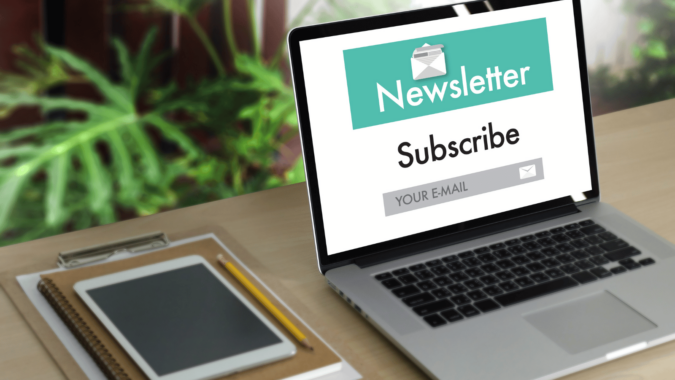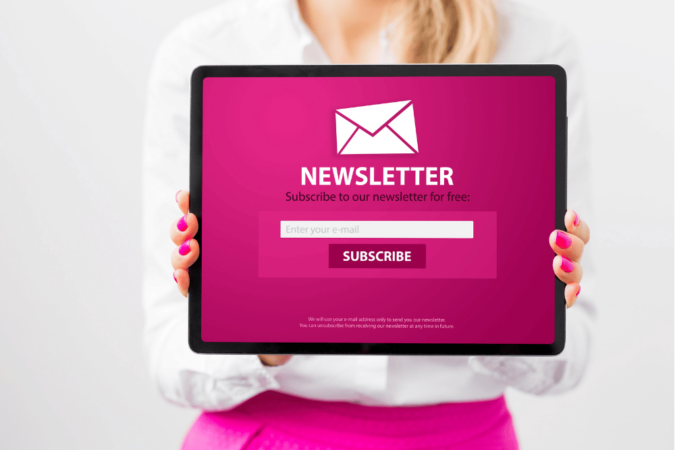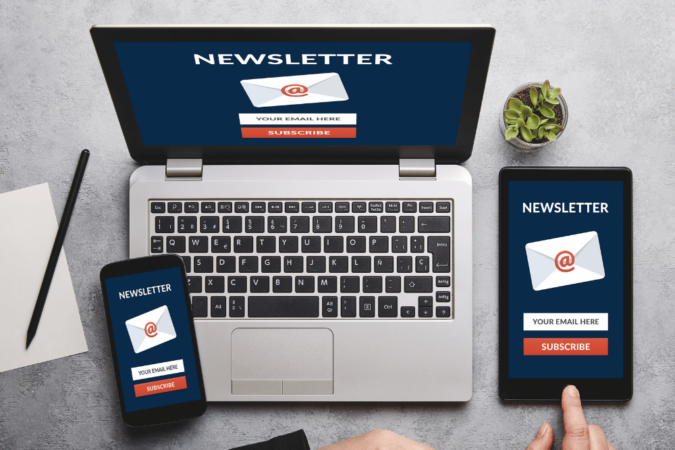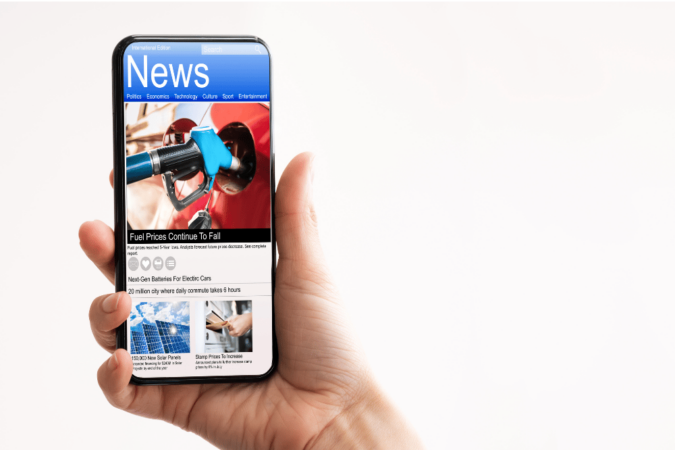
How to Start a Successful Freelance Newsletter

Email newsletters can be an incredibly effective way to promote any business. Using email newsletters, you can reach your target audience directly and with ease. This makes email newsletters a very cost-effective part of your overall marketing strategy.
With email newsletters, you can easily keep customers informed about new products or services, upcoming sales and discounts, special events, or any other relevant information about your business that you want to share.
It’s fast and easy to create email newsletters – plain text, HTML email templates, or integrating editorial content into email are all options you have at your disposal. Plus, email newsletter campaigns are measurable. So you can track the success of each movement in terms of opens, click-throughs, and even sales conversions if desired. Email newsletters are worth considering as part of your overall marketing plan.
What is a newsletter?

A newsletter is an email campaign targeted toward a specific audience to promote and execute marketing plans. It can include relevant content such as recent updates, interesting facts, and special offers that cater to your target audience. It’s all summarized into one email.
Through email marketing, newsletters are welcomed by an audience looking for information about the topic or product being featured. Not only does this offer convenience for the target audience. It also allows individual businesses to capitalize on their marketing strategy.
What are the types of email newsletters?
Email newsletters come in many shapes and sizes. They can be categorized into several kinds. Subject lines are the primary way to capture the attention of readers. A well-written one can get people to open your emails and gain traction toward your direct call to action. User-generated content is also viral in email newsletters.
Stories from users or subscribers tend to grab readers’ attention better than most other types of content. But, then, traditional email newsletters list upcoming events, discounts, and other information users may find helpful. In addition, these often focus on one topic per newsletter. The single-topic approach helps the newsletter creator keep things engaging and informative with each send-out.
Significant Parts of a Successful Freelance Newsletter
An effective email newsletter needs all the right components to be successful, including a compelling subject line that grabs the reader’s attention, a well-written blog post or article, a clear primary call to action, an image with alt text for accessibility requirements, and links back to the business’s various social media channels. Those components must be executed thoughtfully to engage and entice your subscribers.
How to Write an Effective Subject Line for a Successful Freelance Newsletter
As a business owner, you know that email newsletters are one of the best ways to reach your customers. It also keeps them informed about your products and services. But if you don’t have a clear subject line, all that hard work could be for nothing. That’s why it’s essential to understand how to write effective subject lines. You must entice your customers to open your emails.
Keep it Short and Sweet.
Your subject line should be short and sweet. It should be no more than 50 characters if possible. On the other hand, you don’t want to overwhelm your readers with a long and complicated subject line, as they won’t take the time to read it.
Instead, focus on writing something concise yet interesting enough to grab their attention. Ensure that the key points are included right at the beginning. So your readers know what your email is about, even if they don’t read the entire subject line.
Make It Personal
Personalizing emails can make a huge difference in engagement rates and open rates – people are much more likely to open an email when it feels like it was sent specifically for them rather than just a generic message sent out to everyone on your mailing list.
Try including their name or personal details in the subject line, such as mentioning a past purchase or relevant interests. This will show that you value each customer, which can go a long way toward building customer loyalty.
Be Creative
The most effective subject lines stand out from the crowd and immediately capture the reader’s attention. Try injecting creativity into your subject lines by adding emojis or humor (if appropriate). You should also avoid using “spammy” language like “urgent” or “free offer,” as this can turn off potential readers before they even give your email a chance!
An effective email newsletter subject line is essential for getting people to open and read your writing. To achieve this goal, keep it short, personalize it where possible, and inject creativity into it! Spend extra time crafting each subject line to ensure maximum engagement from every subscriber on your mailing list.
10 Tips for Writing a Successful Freelance Newsletter

1. Start by establishing a clear purpose for your newsletter:
Before you begin writing, consider why you are creating the newsletter in the first place. Also, consider what message or information you want to communicate with it. This will help ensure all content chosen is relevant and beneficial to your readers.
2. Keep it concise:
Writing an effective newsletter requires brevity. Your readers likely have limited time to read. So ensure each point is written in as few words as possible while conveying your intended message.
3. Choose strong headlines and images:
Readers often decide whether or not to continue reading based on the headline and accompanying photos. So be sure those elements accurately capture the article’s content, draw attention, and entice readers to read further.
4. Use a conversational tone:
Writing your newsletter in a friendly, approachable style will go a long way toward building relationships with your readers and keeping them engaged.
5. Utilize stories and anecdotes when appropriate:
Including relevant tales or stories can add interest to an article and help illustrate points without being too “salesy.”
6. Incorporate multimedia elements:
Visual mediums such as videos, photos, graphics, or audio clips can make it easier for readers to understand your newsletter’s content and create more engagement from readers.
7. Include links whenever possible:
Inline links can provide additional information about the topics discussed in the newsletter and help drive readers to other relevant content.
8. Regularly review analytics:
Understanding how your readers interact with each newsletter is essential so you can make any necessary improvements or adjustments in the future.
9. Encourage feedback from readers:
Asking for reader input helps ensure that you are writing effective newsletters and allows you to build relationships by engaging with your audience directly.
10. Proofread:
Before sending out a newsletter, it is essential to double-check for any typos or errors that may have been missed during the editing process. This will help ensure that what reaches your readers is of the highest quality possible.
Following these tips can help you write effective newsletters that will capture your readers’ attention and keep them engaged.
Design Considerations for Your Successful Freelance Newsletter

email campaigns are essential for staying connected to your customers and subscribers. The design of the email can make or break its success. For email campaigns to be effective, it’s important to consider best practices when creating them.
To start, you should avoid using too many images or other large files in your email, as this can often result in being sent straight to a user’s spam folder. Additionally, email strategies should always have a clear call-to-action that’s easily identifiable and leads users to where they need to go. Including a text link and a graphic element will help ensure readers don’t miss it.
Ultimately, email campaigns should provide a direct line between subscribers and your business, allowing communication to flow both ways – readers understand what you are offering. At the same time, you can better target them with relevant content. If these design considerations are factored into your email newsletter strategy from the get-go, you’ll be sure to create something that resonates with your subscribers.
Template for a Successful Freelance Newsletter
Subject Line:
{{Newsletter Name}}
Greeting:
{{Dear/Hello/Hi {Name},}}
Introductory Paragraph:
Begin with an introductory sentence that grabs the reader’s attention and leads into your content. Then, include any news or announcements relevant to this newsletter.
Main Content:
This is the bulk of your newsletter. Include stories, articles, and events that are relevant to the audience. Use visuals such as images or videos to break up the text and make it easier to read.
Call To Action:
Depending on what you want readers to do after they finish reading the email, include a call to action that leads them to a specific page or activity.
Closing: End the newsletter with a closing statement thanking readers for their time and attention and any other information relevant to the newsletter.
Sign-Off:
Include your name, title, contact info, website, etc.
Thank You:
Thank you again for taking the time to read our newsletter. We hope you have found this helpful information.
Sincerely,
{{Your Name}}
Best Wishes,
{{Your Name}}
-
Use an attention-grabbing subject line that communicates the purpose of the newsletter and entices the reader to open it.
-
Use a clear and concise layout that makes scanning through the content easy for the reader.
-
Use headlines and subheadings to break up the text and make it more readable.
-
Use bullet points or numbered lists to highlight key points or action items.
-
Include calls to action encouraging the reader to take a specific action, such as visiting a website or purchasing a product.
-
Use images and graphics to add visual interest and break up the text.
-
Keep the newsletter’s tone friendly and personal, and avoid overly formal language.
-
Include a brief introduction that gives the reader an overview of what the newsletter will cover.
-
Use a clear and recognizable font easily read on desktop and mobile devices.
Include a way for the reader to unsubscribe or update their preferences at the bottom of the newsletter.
How to Use Your Newsletter to Grow Your Freelance Business
Creating and sending newsletters can give your freelance business a much-needed boost. An effective newsletter should have interesting content that will draw in readers and keep them returning for more.
It is also a great way to encourage people to visit your website or product landing page. To create a successful newsletter, it is essential to determine the message you want to get across and how often you are willing to send a message out.
Once you have established this, focus on crafting exciting content that will surely be engaging and informative for your audience. This will allow them to connect with your business’s purpose, mission, and goals.
Ten ways to Use Newsletter to Grow Your Freelance Business

1. Promote Your Services:
A newsletter is one of the best vehicles for showcasing your services. So use it to highlight your specialties and expertise every month. Include links to your portfolio, blog posts, or other content demonstrating why you’re the perfect freelancer.
2. Build Relationships with Clients:
Use your newsletter to stay in touch with existing clients and build relationships with potential clients. Share interesting stories about yourself, personal experiences related to work, tips on how to be successful as a freelancer, meetings you attend, and more.
3. Grow Your Mailing List:
If you don’t have many subscribers, add an opt-in link to your emails. Having a more extensive mailing list will make it easier for you to connect with potential clients and promote your services.
4. Launch Your Products:
Use your newsletter to announce the launch of your products or services. Offer discounts, free trials, or exclusive access to content reserved for newsletter subscribers to encourage sign-ups and sales.
5. Network Online:
If you have existing contacts in the freelance community, let them know when you’ve sent out an email newsletter or posted on social media about it too. This will help build relationships with fellow freelancers and increase the visibility of your business online.
6. Provide Value:
Instead of filling your emails with sales pitches, provide Value through helpful content, such as tutorials, tips, and advice about being a successful freelancer. This will help position you as an expert in your field and make it easier to grow your business.
7. Showcase Your Work:
Share any new projects you’ve worked on with your subscribers so they can see the quality of work you produce. If possible, include links to case studies or success stories — this is a great way to build trust with potential clients.
8. Feature Testimonials:
Including testimonials from past and current clients in your emails is one of the best ways to show potential customers why they should hire you instead of another freelancer. Ask for reviews regularly and include them in newsletters when appropriate.
9. Ask for Referrals:
Don’t be shy about asking your existing clients for referrals! Include a call-to-action in your emails to remind clients that you are open to referrals and include links to review sites like Yelp or G2 where they can leave feedback.
10. Stay Up to Date on Trends:
Keep an eye out for any new regulations, trends, or changes in the industry so that you can stay ahead of the curve. Share this information with your subscribers to show them that you’re an expert in the field — this will help build trust and loyalty over time.
By regularly sending out newsletters full of helpful content, valuable updates, and exciting stories related to freelancing, you can grow your business and stay connected with current and potential clients. In addition, make sure to promote your services, build relationships, and show off the quality of work you do — this is the key to success!
How to Distribute Your Successful Freelance Newsletter

When engaging your email list, newsletters are a powerful tool. However, the best way to distribute them is through an email marketing platform that can easily personalize and automate campaigns. This will help ensure your subscribers receive the most engaging newsletters with high-quality content.
To maximize engagement, consider adding exclusive content or special offers in each newsletter––anything from articles and polls to inviting subscribers to play games or watch videos related to the topic. With great content and an easy-to-use distribution system, you’ll be able to keep your audience engaged for years to come!
What is the Best Tool to Create a Successful Freelance Newsletter?
When deciding on the best newsletter tool, Adobe InDesign is ideal. This powerful layout and design program integrates easily with other Adobe applications, allowing users to create beautiful, high-quality images, typography, and graphics for newsletters. In addition, it enables users to choose among different pre-made themes for newsletters or create their custom layouts from scratch.
Moreover, it offers a library of images that can be used as backgrounds, clip art elements, and even complete artwork that can be interchanged within documents. Furthermore, users can access specific features such as peer reviews of designs and linking multiple copies to extend the possibilities while creating appealing newsletters ready for print or digital consumption.
How do you create a newsletter format?
Creating a newsletter format doesn’t have to be a difficult task. However, a few key steps will help get the process started:
- First, it is essential to research the audience for the newsletter and determine their interests and what type of content may best serve them.
- From there, create a clear, concise, and visually appealing layout so viewers can parse through it quickly.
- Additionally, content should be tailored for mobile optimization for readers to digest on their phones or tablets if needed.
- Ultimately, editors should aim to make the newsletter format easily adaptable by testing different fonts, colors, and photos.
Editors strike the right balance between informative and entertaining. After all, these elements draw in readers and improve overall engagement.
Where Can I Create a Successful Freelance Newsletter for Free?
Creating a newsletter doesn’t have to be costly. Plenty of free tools are available that make designing and sending newsletters easy. Mailchimp, Dotstudioz, SendPulse, and Zoho Campaigns are just a few of the free options.
With user-friendly templates, customized branding elements, automated greetings, and email reminders, these platforms can help you create a professional newsletter for any audience in no time. All that’s left is deciding what content goes where—and that task is up to you!
What Are the Five Elements of a Successful Freelance Newsletter?
An effective newsletter is vital to increasing viewership and engaging the public. Five key elements are good visuals, concise writing, engaging and relevant topics, a clear call to action, and a consistent schedule.
- Good visuals should be informative and eye-catching, while concise writing should communicate the message efficiently without being too wordy.
- Finally, engaging and relevant topics should be tailored to the target audience and recent events to stay current.
A clear call to action will spur readers into taking whatever step they desire. Finally, having a consistent schedule for releasing new content will help keep returning readers interested in the newsletter. Any business or organization can create an influential newsletter that engages its readers by focusing on these five elements.
What Are the Three Characteristics of Successful Freelance Newsletter Headlines?
Crafting a headline for a newsletter is an essential step in its overall success, as it can mean the difference between someone continuing to read or moving on to another piece of content. Therefore, an effective headline should be clear, concise, and compelling.
Clear headlines provide readers with an immediate understanding of the article, while conciseness ensures it works with any online platform’s character limit. Additionally, evoking emotion increases engagement and encourages readers to carry on.
Whether it’s providing intrigue or humor, a successful newsletter headline should have something compelling to draw readers in and inspire them to explore further.
How Do you Engage Someone in a Successful Freelance Newsletter?
When trying to engage readers in a newsletter, good writing is essential. Utilize a conversational tone and focus on stimulating their interest by providing valuable and relevant content. Personalize it as much as possible, using friendly and professional phrasing. Address the audience directly using words like “you” and “your.”
Ask questions throughout the piece to further draw the reader and connect them to the content. Then provide interesting answers or solutions they can be sure to benefit from. Keeping it short yet witty is an effective way of maintaining engagement, as readers will often lose interest in longer newsletters.
Offer incentives such as discounts or free samples if applicable. Finally, keep your writing fresh by incorporating elements of humor whenever possible. Following these tips will make interested readers enticed to return for future newsletters!
What are common mistakes things to avoid when making a newsletter?
1. Not considering a target audience:
Many people forget to consider the recipient when constructing their newsletter. So, it’s essential to tailor your content and design elements. So they make sense to the intended audience.
2. Ignoring branding opportunities:
Your newsletters should always include branding elements such as logos, colors, and fonts consistent with your business or organization’s overall look and feel. Doing this helps readers recognize your brand quickly without reading any text.
3. Improper use of images:
Poor-quality images can easily distract from your message, making it difficult for readers to focus on the content. Always use high-resolution photos that fit well within the layout of the newsletter template you’ve chosen.
4. Repetitive content:
Keeping the content fresh and exciting is essential if you’re sending out newsletters regularly. Unfortunately, reusing old content or repeating the same topics can quickly become boring for readers.
5. Lacking a compelling call-to-action:
Your newsletters should have a clear objective and associated call-to-action that encourages recipients to take action, such as visiting your website, downloading a resource, subscribing to more content, etc. Without this, readers may feel like there was no purpose for them receiving the newsletter in the first place.
6. Too many options:
Including too many links or calls to action within one newsletter can overwhelm readers. Instead, focus on just one or two points of contact you’re trying to drive your audience towards.
7. Not proofreading:
Poor spelling and grammar mistakes can quickly prevent recipients from reading the entire newsletter. Therefore, always take the time to review and proofread your newsletters before sending them out, even if this means hiring a professional editor for help.
8. Not optimizing for mobile devices:
With more people using their mobile devices to view emails than ever, ensuring that your newsletters are optimized for different device sizes, and types of screens is essential. This includes ensuring that images display correctly, the text is readable, links are clickable, etc.
9. Not testing before sending:
Always take the time to test your newsletter on multiple devices, browsers, and email clients to ensure that it looks and functions as expected. Doing so will help you identify any issues before they occur and prevent potential problems with delivering the content to readers.
10. Sending too often:
You don’t want to send out newsletters too frequently, or your recipients may quickly become overwhelmed by the number of emails they receive from you. Instead, focus on sending out only relevant content when necessary rather than flooding people’s inboxes with newsletters immediately.
11. Not taking advantage of automation:
Automating your newsletters can help save time and ensure they are sent out consistently on the same day and time each month or week. Doing this will help you stay organized, keep readers engaged, and free up more time for other tasks.
12. Forgetting to track results:
Always take the time to review analytics such as open rate, click-through rate (CTR), unsubscribe rate, etc. This will help you identify any areas where improvements could be made to make your newsletters even better in the future.
By avoiding these mistakes when creating a newsletter, you can ensure that your content is well-received by readers and effectively drives them toward taking action. So check off each item on the list to confirm your newsletter is up to par and ready for success!
Strategies for Growing Your Audience and Gaining Subscribers

The best way to increase your newsletter’s reach and grow your subscriber list is by leveraging social media. Social media provides a platform for sharing snippets of your newsletters, linking to them, and interacting with your current and potential subscribers.
Promote Awareness
Platforms such as Facebook, Twitter, Instagram, YouTube, and LinkedIn can be used to promote awareness of your newsletter. Additionally, consider creating online ads or sponsored posts on popular platforms like Google Ads or Facebook Ads targeting the correct audience.
Engage Members
To keep members engaged in your newsletter content, it is essential to ensure that you constantly update the topics within each issue. This could include keeping up-to-date with industry news, trends, and events related to your topic or niche. Additionally, exciting stories and relevant content will keep readers interested and add interactive elements such as polls and quizzes for a more engaging experience.
Reach Your Audience
Reaching out directly to potential subscribers via email campaigns or influencers is also essential. You must spread the word about your newsletter. By leveraging organic search engine optimization (SEO) tactics, you can ensure that your newsletter appears at the top of search results when potential readers search for related topics.
Review and Monitor Analytics
It’s essential to review and monitor analytics regularly. You must understand how many people engage with each issue of your newsletter and what type of content resonates most with them. This data can be used to develop newsletters tailored to your audience’s interests.
Incentivize Subscribers
Offering incentives for subscribers who promote your newsletter or provide subscriber-only content to incentivize readers to sign up. Stay engaged with each issue to grow your audience and increase subscribers. Leverage social media platforms and influencers to spread the word about new offers or special deals you run for existing subscribers.
Increase Your Newsletter’s Reach
These strategies will help you increase your newsletter’s reach, grow your audience, and increase subscribers over time. With continuous effort and experimentation, you will be able to develop an engaged community of loyal readers who enjoy reading your content regularly.
Bottom Line – Successful Freelance Newsletter
A newsletter is a great way to keep in touch with your audience and cultivate relationships leading to new freelance opportunities. Following the tips in this blog post, you can create an effective newsletter to help you grow your freelance business.
Keep your subject lines exciting and personal, focus on quality over quantity, and make sure your design is clean and easy to read. Use your newsletter as a platform to showcase your work, share helpful resources, and build trust with potential clients. If you need help getting started or want more information on using newsletters effectively, contact us or check out our other blog posts.





